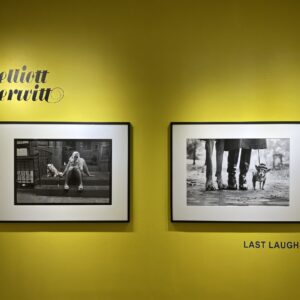JTF (just the facts): Published by Pomegranate Press in 2020 (here). Softcover, 40 pages, with 37 color photographs and a drawing by Elijah Anderson. In an edition of 200 copies. Design by Jesse Feinman. (Cover and spread shots below.)
Comments/Context: Sam Youkilis, a New York-based photographer, graduated from Bard College with a degree in photography four years ago. His work revolves around the frantic experience of tourism and travel, both the landscapes themselves and people’s interactions within them. Youkilis’s short videos and photographs shared on his Instagram (linked in the sidebar) show scenes from a variety of exotic locations: an indoor bathhouse, beaches, food markets, small wineries, etc. He pays close attention to movements and lines, tying the images together through the use of colors, geometries, and brightly lit perception, and carefully playing with the clichés of tourist photography.
Youkilis has recently published a zine filled with photographs taken during a trip through South America a few years back. Titled El Mirador, it was released by Pomegranate Press, an independent publishing house based out of Richmond, VA. Founded in 2015, Pomegranate specializes in showcasing contemporary photography through the release of affordable publications.
El Mirador is a perfect bound zine with soft touch matte laminated cover. It starts with a lush cover image of an old basketball hoop with a missing net, shot against a sky changing from red to blue. The combination of colors and the underneath angle makes the photograph immediately stand out, in an unreal way. There is no text on the cover, and a simple list of captions indicating the locations where the images were taken appears at the very end of the book.
The opening photograph shows a woman walking among the terraced salt ponds of Maras, Peru. It’s a scene we have scene before (although such images typically involve rice paddies), but it’s more resonant than usual because of the milky tones of the water. The woman wears a panama hat to protect her from the direct sun and rubber boots, and carries a bowl; she likely works there, as the salt ponds are used by local families to farm salt for sale. The blue color of her sweater neatly matches the title of the publication, El Mirador, printed on the left side of the spread in the script font, signaling that Youkilis is paying close attention to how color connects and echoes.
The following spread pairs two striking photographs from Potosi, Bolivia. The image on the left captures a tiny pink flamingo with its head down, probably eating plankton, as it stands in the middle of shallow pink water. It was taken at Laguna Colorada, a shallow salt lake filled with hundreds of rare flamingos. The picture on the right depicts two cars with loads on their roofs, traveling across the sugar white glass-like surface of salt flats; the clouds above reflect off the surface of the land, creating the illusion of driving through the sky. This is another incredible place in Bolivia, Salar de Uyuni, the largest salt flat in the world. In both images, Youkilis plays with scale and perception, creating surreal and mesmerizing photographs.
There is no obvious linear story here, and while the locations are indicated in the captions, Youkilis’s photographs could have been taken almost anywhere – they are almost generic, not specific. By removing his subjects from their context, he puts the focus on their formal arrangements and chromatic ranges. There are plenty of excellent pairings in the zine, and one of the most beautiful makes us look up into the sky. A black and white photograph of tall, thin palm trees shot against a clear white sky is juxtaposed with an image capturing a sky dotted with tiny silhouettes of birds, both images using high contrast to reduce nature to visual patterns.
Occasionally Youkilis’s images include people. Two police officers stand next to the wall leaning forward on protective riot shields, as a little boy playfully points his toy gun at one of them; the image to its left captures a geyser and its cloud of steam, yet it also looks like an explosion, building tension in the visual conversation between two photographs. In another set, a black silhouette of a bold man in profile, shot against the sky changing in sundown, is paired with an image of a rocky landscape covered with small spiky desert plants. Stripped of their locations and narrative meanings, Youkilis’s photographs become curious independent visual studies.
Many clever pairings keep us on our toes. A busy swimming area is matched with a sign for the toilet, two kids riding bicycles are matched with two apartment towers, and the curves of ski slopes are placed with those of cacti. The last photograph in the zine returns back to the terrace of salt ponds of Maras, the walk that started with the woman now ending with a different man. On the right side, there is a black and white illustration showing a group of tourists walking in the direction of a sign that reads “El Mirador, 200 m.;” apparently, we haven’t even arrived yet at the main attraction.
El Mirador is an unpretentious and subtly elegant publication, enlivened by thoughtful sequencing and editing. It is a story of perception, of looking at the obvious and seeing something more. It is another successful example of how the flexible zine format can be effectively used to share an intimate, self-contained project with a much wider audience.
Collector’s POV: Sam Youkilis does not appear to have consistent gallery representation at this time. As a result, interested collectors should likely follow up directly with the artist via his website (linked in the sidebar).



















